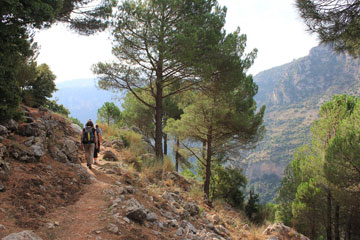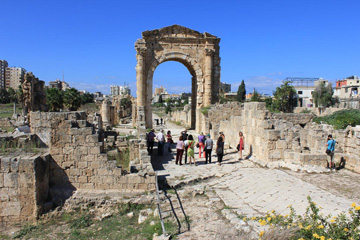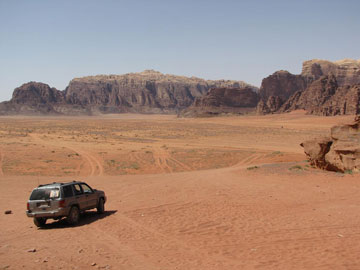ANCIENT LEBANON AND JORDAN:
HISTORY AND ARCHAEOLOGY
HISTORY AND ARCHAEOLOGY

The 'Treasury' at Petra
"It seems no work of Man's creative hand,
By labor wrought as wavering fancy planned;
But from the rock as if by magic grown,
Eternal, silent, beautiful, alone!
Not virgin-white like that old Doric shrine,
Where erst Athena held her rites divine;
Not saintly-grey, like many a minster fane,
That crowns the hill and consecrates the plain;
But rose-red as if the blush of dawn,
That first beheld them were not yet withdrawn;
The hues of youth upon a brow of woe,
Which Man deemed old two thousand years ago.
Match me such marvel save in Eastern clime,
A rose-red city half as old as time."
By labor wrought as wavering fancy planned;
But from the rock as if by magic grown,
Eternal, silent, beautiful, alone!
Not virgin-white like that old Doric shrine,
Where erst Athena held her rites divine;
Not saintly-grey, like many a minster fane,
That crowns the hill and consecrates the plain;
But rose-red as if the blush of dawn,
That first beheld them were not yet withdrawn;
The hues of youth upon a brow of woe,
Which Man deemed old two thousand years ago.
Match me such marvel save in Eastern clime,
A rose-red city half as old as time."
John William Burgon, �Petra� (1845)
THE TOUR
This three week Study Tour explores the archaeology, history and culture of Lebanon and Jordan. The tour begins in Beirut with a visit to the Downtown quarter of the city with its Crusader church of St George and roman baths. We also see the fascinating collection of artefacts in the Museum of the American University of Beirut. The following day we head north of Beirut, stopping to explore the collection of ancient Egyptian and Assyrian stelae at the �Dog River� and to see the stunning Jeita Caves, one of the great natural wonders of the Near East. In the Lebanon Hills we explore the roman Temple of Adonis at Faqra.
Our tour then takes us to Byblos where we stay for 2 nights. This stunning archaeological site contains a rich history going back to early days. We explore the antiquities and on-site museum, and there is free time to wander the mediaeval streets and walls.
We then head north of Byblos, stopping at the dramatically located Moussalayha Crusader period Castle before we continue our journey to Tripoli. This traditional Near Eastern town preserves a feel of the medieval world with its fascinating old quarter markets and Great Mosque. We also visit the dramatic 12th Century Crusader Castle of St Giles on the eastern edge of the city. We then head into the mountains to visit Bcharreh and its Museum to Khalil Gibran, author of the �The Prophet�. We visit the Maronite Monastery of Qozhaya, and spend a morning walking in the superb Qadisha Valley where we see a number of hermitages and monasteries created in the caves. In the afternoon we also visit one of the nearby cedar reserves.
Our tour then takes us to the Beqaa Valley in eastern Lebanon where we visit the sprawling remains of the Umayyad Place at Anjar. We also explore the remarkable Roman temples at Baalbek, one of the great archaeological sites of the Near East. In the afternoon we visit a winery which still uses ancient Roman cellars. We head south the following day, stopping to see Niha Roman Temple and tour the beautiful Beiteddine Palace, an 18th Century masterpiece overlooking a dramatic valley. We overnight in the picturesque hill town of Deir el Qamar.
Our journey takes us down to the coast where we see the Phoenician Temple of Eshmoun, and the mediaeval quarter of Sidon with its beautiful Crusader Castle. We head to Tyre where we explore the fascinating Roman ruins. We then return to Beirut where we visit the National Museum, home of a superb collection of Phoenician and Roman artefacts.
The next day we fly to Amman, capital of Jordan, which will be our base for five nights. From here we explore the antiquities in the local region. We head north of Amman to visit the stunning remains of the Roman city of Jerash. We also see the antiquities of the National Museum in Amman and walk around the ruins of the ancient city, including the Roman theatre, Temple of Hercules, and Ummayad palace. We have a day excursion into the eastern desert of Jordan to explore the fascinating Umayyad �Desert Castles�, a series of forts and caravanserais from the early Islamic period (8th Century AD). The following day we see the Roman mosaics at Madaba, visit the church at Mt Nebo, swim in the Dead Sea, and visit the site of traditional Baptism site of Jesus on the Jordan River.
We then head south of Amman, stopping en route to see the dramatic Crusader castles of Kerak and Shobak. We check into our hotel in Petra which will be our base for the next five nights. We spend 2 days exploring the stunning ruins of Petra, the fascinating Nabataean city carved into the red sandstone cliffs. There is a free day to relax, shop or explore more of this fascinating site (an optional visit by night to see 'the Treasury' lit by candles is highly recommended). We also spend a day exploring the dramatic desert scenery of Wadi Rum by 4-wheel drive. Our tour concludes by returning to Amman for our flight to Australia.

The Roman Temple of Bacchus at Baalbek
ITINERARY*
Day 1: Depart Australia
Our flight on Etihad Airlines leaves Australia with a short stop over (usually a few hours) in Abu Dhabi before we connect to our flight for Beirut.
Day 2: Arrive Beirut - walk Downtown, American University Museum
We arrive into Beirut mid morning. After a rest we have some lunch then go for a walk in the Downtown of Beirut. We see the Church of St George and the Omari Mosque and view the remains of the Roman Baths. In the afternoon we visit the small museum of the American University of Beirut which has an excellent collection of artefacts covering the history of Lebanon.
 |
 |
Mosaic in the National Museum, Beirut |
Crusader castle at Byblos |
Day 3: Nahr el-Kalb stelae, Jeita Grotto, Faqra Roman Temple
In the morning we leave Beirut and head north. We stop at the 'Dog River' to see the famous stelae erected by the ancient Assyrian, Egyptian and Babylonian armies as they passed through Lebanon. We then explore the enormous Jeita Caves, with their stunning limestone formations. After lunch we drive into the Lebanon hills to see the remains of the Roman era Temple of the god Adonis at Faqra. We drive to Byblos which will be our base for 2 nights.
Day 4: Byblos ruins - free time to explore the medieval city
The morning is spent in the wonderful ruins of the ancient Phoenician city of Byblos (modern Jbail). These include the Temple of the Obelisks, the Phoenician royal tombs and the Crusader Castle. A small site museum explores the history of this fascinating place. In the afternoon there is some free time to wander around the mediaeval quarter of the city including the Crusader church of St John the Baptist and the well preserved Mamluk era walls.
Day 5: Moussalayha Castle, Tripoli Castle and old quarter, Bcharreh
In the morning we leave Byblos and head north. We stop briefly to see the mediaeval Muslim castle of Moussalayha, perched on the top of an isolated rock. We then head to Tripoli where we explore the dramatic Castle of Saint Giles, built by Raymond of Toulouse in 1104. We go for a walk through the old quarter of Tripoli where we see the 13th Century Great Mosque and explore the old markets and khans. In the afternoon we head to Bcharreh in the Lebanon mountains, where we see the Museum of the author Khalil Gibran and visit Qozhaya Monastery.
Day 6: Qadisha Valley - walk in the Cedar reserve
In the morning we go for a 3-hour walk in the stunning Qadisha Valley. Our path takes us through scenic landscapes as we visit isolated Maronite hermitages and monasteries, many of which are carved into caves in the sides of the valley. A number of churches are decorated with Byzantine era frescoes. In the afternoon we visit one of Lebanon's cedar reserves which protects ancient stands of cedar, some up to 1500 years old.
 |
 |
Walking in Qadisha Valley |
Umayyad palace City at Anjar |
Day 7: Anjar Umayyad Palace - Baalbek - Ksara Winery
In the morning we head south and then cross the Lebanon Mountains into the fertile Beqaa Valley. Here we explore the ruins of Anjar, an 8th Century Umayyad royal city which was built by Walid I as a retreat from Damascus in the scenic countryside. We have some lunch and then explore the stunning remains of the Roman Temples of Baalbek. The site has some of the best preserved Roman temples anywhere, and includes temples to Venus, Jupiter and Bacchus. In the afternoon we visit the Ksara Winery which uses Roman cellars. We stay overnight in the pleasant town of Zahle.
Day 8: Niha Roman Temple - Deir el-Qamar - Beiteddine Palace
The morning is set aside to explore the picturesque ruins of the Roman Temple of Hadaranes at Niha. From here we head to the city of Deir el Qamar in the Chouf Mountains. The capital of Lebanon in the 17th Century, the town preserves a number of grand buildings from this time. In the afternoon we explore the magnificent Beiteddine palace, built by Emir Bashir in the late 18th Century. It contains a wonderful collection of Byzantine Mosaics from the area. We stay overnight in Deir el-Qamar.
Day 9: Temple of Eshmoun - Sidon Old City
We drive through the scenic Chouf Mountains and then descend to the coast. We stop to see the remains of the Phoenician Temple of the god Eshmoun on the outskirts of Sidon. The temple preserves remains of the shrine to Astarte including a throne dedicated to the goddess. We then head to Sidon on the coast where we explore the medieval Crusader castle and take a walk through the Old City. We drive to Tyre and check into our hotel.
Day 10: Tyre - drive to Beirut
In the morning we explore the ruins of Tyre. The town preserves extensive remains of the Roman era including the main street and triumphal arch, the ruins of a hippodrome and a remarkable cemetery containing numerous carved sarcophagi. We also explore the ruins along the seafront which include a Roman bath and gymnasium. In the afternoon we head to Beirut.
 |
 |
Beiteddine Palace |
The Roman ruins at Tyre |
Day 11: Beirut National Museum - fly to Amman
In the morning we visit the National Museum in Beirut. Badly damaged in the civil war, the Museum has been fully restored and contains a superb collection of artefacts covering the history of Lebanon. Highlights include the sarcophagus of King Ahiram of Byblos, and the golden treasure from the tombs. In the afternoon we fly to Amman, the capital of Jordan.
Day 12: Jerash
In the morning we head north of Amman by bus to explore the magnificent Roman ruins at Jerash. One of the wealthiest cities of the Decapolis (Land of Ten Cities), Jerash thrived on overland trade and acquired impressive Roman buildings including theatres, temples and colonnaded streets. A highlight is the impressive circular forum. In the afternoon we return to our hotel in Amman.
Day 13: Archaeological Museum - Amman Citadel and Roman theatre
In the morning we visit the National Archaeological Museum of Jordan in Amman which contains a fascinating collection of artefacts from Jordanian history. Artefacts include Neolithic plastered skulls, Bronze Age pottery, Hellenistic and Roman artefacts and Nabataean art and pottery. After lunch we walk around the Umayyad remains on the citadel of Amman, see the remains of the Temple of Hercules, and explore the well preserved Roman theatre.
Day 14: The 'Desert Castles' of the Eastern Desert
The day is set aside for a day trip to explore the 8th Century Ummayad ruins in the eastern desert of Jordan. These sites include the spectacular remains of the palace at Qasr Mushatta, the fortified residence and meeting place at Qasr Hraneh, the remarkable decorated baths of Qusayr Amra, the black stone castle of Azraq where Lawrence of Arabia planned his attack on Damascus, and the fortress of Hallabat with its Umayyad mosaics.
 |
 |
The circular forum at Jerash |
The Roman theatre in Amman |
Day 15: Madaba, Mt Nebo, Dead Sea, Baptism site on the Jordan
This day trip examines some of the fascinating sites near Amman. In the morning we see the impressive Byzantine mosaic of the Holy Land in the church at Madaba. Our journey takes us to the top of Mt Nebo, the site where Moses is said to have first seen the Holy Land, and where we visit the recently rebuilt Church. We then stop for a swim in the Dead Sea, enabling us to experience the strange sensation of bobbing in the salty water. This day trip concludes at the Jordan River where we visit the suggested site of Christ�s Baptism before returning to Amman.
Day 16: Kerak Castle - Shobak Castle - arrive Petra
In the morning we head by bus down the Kings Highway stopping to see the superb view over the Wadi Mujib. We explore the impressive remains of Kerak Castle, built by the Crusaders in the 12th Century to dominate the region. After lunch we continue south, stopping at the site of Shobak to see the remains of the medieval castle. Built on an isolated hill, the castle is famous for its deep water tunnel. In the late afternoon we head to the modern town of Petra where we check into our hotel.
Day 17: Petra Day 1 - the 'Treasury', High Place and Royal Tombs
In the morning we leave Amman and head south down the Kings Highway stopping to see the superb view over the Wadi Mujib. We explore the impressive remains of Kerak Castle, built by the Crusaders in the 12th Century to dominate the region. After lunch we continue south, stopping at the site of Shobak to see the remains of the medieval castle. Built on an isolated hill, the castle is famous for its deep water tunnel. In the late afternoon we head to Petra where we check into our hotel.
Day 18: Petra Day 2 - the Central City and Ed-Deir
In the morning we continue our exploration of the magnificent site of Petra. We see the central part of the site including the Great Temple and the churches. Those who are energetic and adventurous can accompany the guide by walking (or taking a donkey) to explore the incomparable Ed-Deir, 'the Monastery', a spectacular funerary temple carved out of the native rock. The views over the Wadi Arabah are magnificent and the funerary temple is one of the most impressive sites in the Near East.
Day 19: Free day in Petra
This day is set aside for rest and relaxation. Your ticket to Petra will give you entry back into the site if you would like to see more of this remarkable place. It is also possible to arrange a visit to 'Little Petra', a Nabataean caravan stop north of Petra which is carved in a similar style.
 |
 |
The 'Monastery' at Petra |
The spectacular Wadi Rum |
Day 20: Wadi Rum
In the morning we head south by bus to explore the splendid natural wonders of the Wadi Rum, a stark desert landscape which stretches far away. We travel by 4-wheel drive down the Wadi stopping to see magnificent isolated oases around natural springs and explore the Nabataean temple. In the afternoon we return to the modern town of Petra - there is free time to rest and relax or wander in the town for last minute shopping.
Day 21: Depart Amman
In the morning we head north by bus up the Desert Highway to Amman International Airport. We board our plane for the flight back to Australia. There is a short stop en route at Abu Dhabi.
Day 22: Arrive in Australia
Arrive back in Australia.
* Please note that the Company reserves the right to make alterations to the itinerary in the period up to 60 days prior to a tour departure. The itinerary may also be subject to minor re-arrangement due to the scheduling of the operators and availability of access. If this occurs, the Company will endeavour to provide a comparable alternative.

